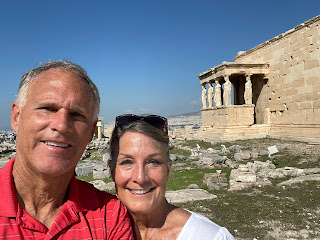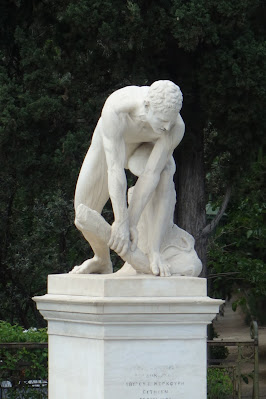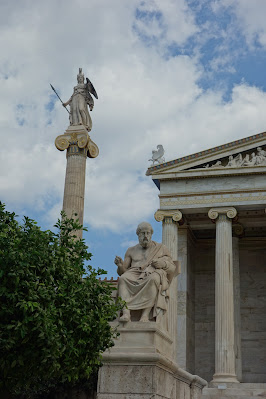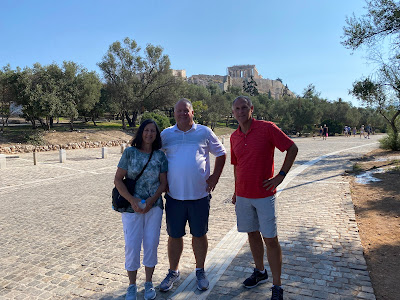In hindsight, we can see the blessings of things that didn't turn out the way we thought best. Such is the case as I reflect upon our visit to Athens in 2018. See previous post here. One of my regrets from that visit was that we did not tour the Ancient Acropolis. Little did I know that on September 4, 2022, Bob and I would return to the city with Jim and Shauna, with the intent to visit the Acropolis. It was a beautiful, but intensely sweltering hot day, and the crowds of tourists made it difficult to enjoy our surroundings. But I'm grateful for the opportunity to return to Athens.
So, just what did we see as we meandored atop the bluff filled with ancient ruins? . . .
The Acropolis of Greece
Propylaea: The propylaea were the monumental gates to the Acropolis. It serves as a partition, separating the secular and religious parts of a city. It was built wide enough to allow chariots to enter the city and included some buildings. I don't know if it's true, but as I studied these ruins, I couldn't help but think that this architecture was the inspiration for Legos blocks. (Do you see it in the middle photo?)
The Odeon of Herodus Atticus: The odeon on the south slope of the Acropolis of Athens was built by Herodus Atticus in 161 CE in memory of his wife Aspasia Annia Regilla. It could accommodate up to 5,000 spectators at a time. It was fully reconstructed in the 1950's and is now again used for concerts and events.
The Temple of Athena Nike: The Temple of Athena Nike, located on the south side of the Propylaia, is a temple built in 420 BC, dedicated to Nike, a form of Athena believed to be the goddess of victory in Greek mythology. It sits at the south end of the Acropolis to the front of the Propylaea. It can be well see from afar.
The Erechtheum (Erechtheion): Located on the north side of the Acropolis, this temple is dedicated primarily to Athena. The eastern part of the building was dedicated to Athena while the western part served the cult of Poseidon. This is where, according to the myth, Athena's sacred snake lived. There was a dispute between Athena and Poseidon for the possession of the city of Athens. The legends tell of a sea Poseidon caused to well up during the contest, long believed to be under the building, and of the olive tree that Athena caused to sprout on this spot and that marked her victory. And in this location was kept the olivewood statue of Athena. This is the most interesting building on the rock and the porch of the maidens is one of it's highlights.
The Parthenon: The Parthenon is regarded as the finest example of Greek architecture. It was built in 500 BC as a temple dedicated to Athena. It was destroyed by the Persians in 480BCIt is one of the greatest cultural monuments and a representation of Ancient Greece, Athenian democracy, and western civilization, and is, perhaps, the centerpiece of the Acropolis. Unfortunately, much of it was covered with scaffolding during our visit, which may have impacted the mediocre impression I had when seeing it. Nevertheless, it is an iconic structure, and I'm glad we finally saw it.
We strolled to the north side of the rock, where a Greek flag The Greek flag is situated on what was a belvedere tower during the medieval period of the Acropolis. This was a great vantage point for taking photos of Athens - including Mount Lycabettus, Mars Hill or Areopagus Hill, Temple of Hephaestus, interesting architecture, and the Stoa of Attalos, a major shopping center in the ancient Agora, and is now a museum.
Other Sites in Athens
After spending the morning on top of the big rock in Athens, our driver took us around to other interesting sites in the city.
Areopagus (Mars) Hill: A rocky hill in Athens, north-west of the Acropolis, where the Athenian supreme tribunal and court of morals was held. In pre-classical times (before the 5th century BC), the Areopagus was the council of elders of the city, like the Roman Senate. Like the Senate, its membership derived from those who had held high public office. From some part of this hill Paul delivered the address recorded in Acts 17:22-31, where he addressed the false beliefs of the Greek and their worship of an unknown God.

Athens Hellenic Parliament and Changing of the Guards: Construction on the building lasted from 1836 to 1842. Originally, it served as the palace of the King of Greece. It was inhabited by King Otto and his wife, Queen Amalia, and later by King George I and his family. However, in 1909, a fire caused extensive damage to the building and restoration works started. When the monarchy was abolished in 1924 the building was used as a museum and a hospital. In November 1929, the government decided to move the Parliament House to this building. The changing of the guards ceremony is so much fun to watch. Did I mention that those pompom shoes disguise a knife insert in case needed?
Olympic Stadium: It is the only stadium in the world built entirely of marble. It can seat at least 50,000 people. The stadium originally had a rectangular shape that was typical of ancient Greek stadiums. The stadium was host to the first modern Olympic Games in March 1896. Greek athlete Spyridon Louis won the Marathon race, bringing a whole new level of joy to the country.
Temple of Zeus: The temple was constructed between c. 472 and 456 BC in honor of Zeus, and housed the renowned statue of Zeus, which was one of the Seven Wonders of the Ancient World. The gold and ivory statue was approximately 43 feet high and took 13 years to create. The temple was one of the largest in the world. Only a few remains can be seen today.
Academy of Athens: An exceptional example of neoclassical architecture, home to the highest research institute in Greece. It was built in two phases, in 1859-1863 and 1868-1885, with statues of Athena and Apollo erected upon the two front pillars. It's purpose is the advancement of the
Sciences, Humanities and Fine Arts.
Harbor: Near the Port of Piraeus we stopped at the most exclusive marina Mikrolímano. It was so nice to sit in the scenic harbor and enjoy a meal together before returning to our ship. Now I could return home, completely satisfied that I had seen enough of Athens. (Although the locals would surely disagree.)
With a farewell to Athens, we returned to the sea aboard our colorful ship for a relaxing evening of food and music in the centrum lounge.


















































































No comments:
Post a Comment